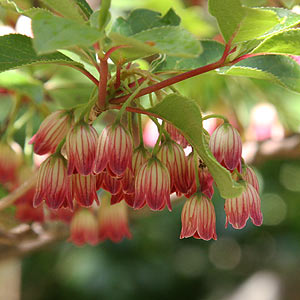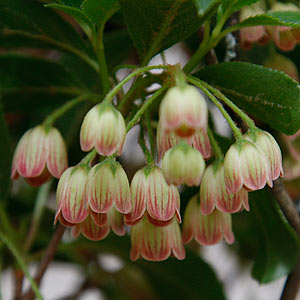
It is not that often that a plant lives up to its name, however Enkianthus campanulatus ‘Showy Lantern’ (pictured right) certainly does.
Sometimes called the ‘Red Vein’ Enkianthus, however if you were in Japan you might prefer to use ‘ furin-tsutsuji’. This is an upright species, so give it the right space.
The flowers of Enkianthus campanulatus ‘Showy Lantern’ are exactly as you would think, hanging like little lanterns and certainly very showy.
The whole genus is actually one of the most graceful and charming woodland plants we have had the pleasure to grow. E. perulatus has pendulous white flowers, and if you are looking for fall co lour, the whole genus seems to have it in spades.

Flowering in spring to early summer depending on your zone and the season, if you are looking for a plant with wonderful flowers for dappled shade, this could well be it.
These plants are from Asia, from the Himalayas through to China and Japan, always from the foothills. A lot of variety in flower color, with Enkianthus campanulatus ‘hiraethlyn’, pictured below right being a little more restrained.
Care
Although these plants are relatively easy to grow they are a little bit fussy. we often talk about humus rich well drained soil, well with Enkianthus we really do mean it.
In fact these are also one of the few plants we would go to the trouble of amending soil pH for, they do like a slightly acidic soil. Although we must say we also amend the soil for peonies, but the other side of the pH scale.
These are also plants that require little to no pruning. They are naturally graceful and well behaved. Remove any dead or damaged wood only.
Care summary
- Humus rich moist soil
- Good drainage is essential
- Slightly acidic soil
- Extra moisture during dry summers
- Good dappled shade to part sun – the warmer the climate, the less sun
- Best in USDA Zones 4-8
- Growth rate – slow
Varieties
Although around 10 species are recorded, only two are widely in cultivation, along with a few hybrids as mentioned.
- Enkianthus campanulatus
- Enkianthus campanulatus ‘hiraethlyn’
- Enkianthus campanulatis var. palibinii .Flowers have more red in them than the species.
- Enkianthus perulatus has yet to come up with name that matches its larger growing relative, this low growing and relatively diminutive species has its own appeal.
Propagation
Propagation is easiest from cuttings taken in summer. It is also possible to grow Enkianthus from seed, however it is a slow process.

